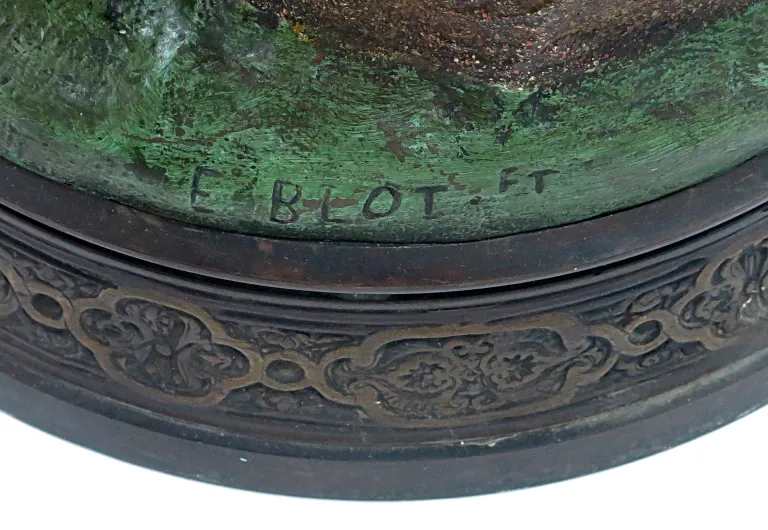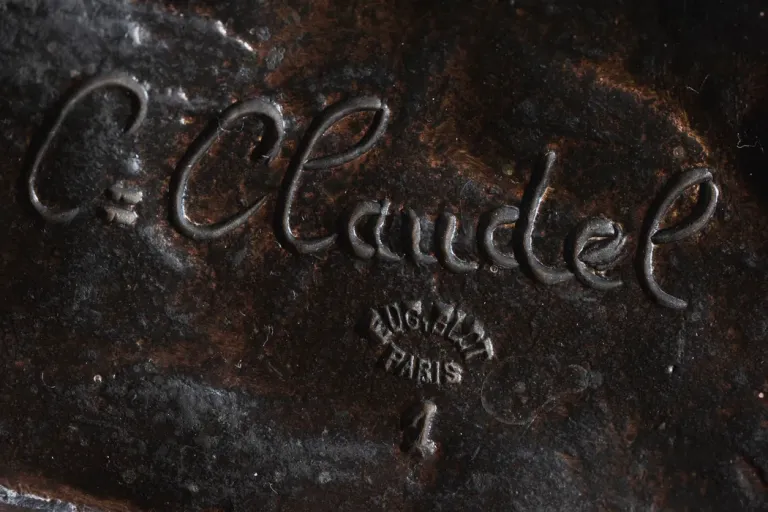
When you spend a lot of time browsing art auctions, the name Eugène Blot appears regularly. His name is shown as fondeur (bronze founder) on several sculptures by Emmanuel Villanis and also on those by Camille Claudel. Who was this man?
Wikipedia lists two pages bearing his name, but one Eugène Blot is a painter and the second Eugène Blot – a sculptor also turns out not to be the Eugène Blot-the-bronze-founder we’re looking for.
When so little is known, that only makes you more curious — at least, it did me …
The Search
When there’s no information on Wikipedia, and therefore no reliable source material, the search suddenly becomes much more difficult. Add to that the fact that the name Eugène Blot is not at all unique in France, and such a search takes you everywhere and nowhere …
Search engines produce hits but no indication of reliability. Many antique dealers repeat the same story in slightly different words. It seems to have been copied from each other and largely originates from Pierre Kjellberg’s Bronze Bible.
It goes roughly as follows:
In 1874, a factory of “artistic zinc” is mentioned under the business name Blot et Drouard.
In 1878 this factory exhibited several of its bronze imitations, including some by Guillemin and Dumaige.
By the end of the 19th century, Eugène Blot — probably the son of his predecessor — was a publisher of bronzes and the owner of an exhibition gallery at 5 Boulevard de la Madeleine, where one could find paintings by great Impressionist painters, lamps, trinkets, and bronze sculptures by Constantin Meunier, Hötger, Jouant, Van der Straeten, Roger-Bloch and Camille Claudel.
All these bronzes were published by Eugène Blot. He especially admired Camille Claudel, whose works he published in limited and numbered editions.
Quoting Mirbeau, he later wrote that she “is to Rodin what Berthe Morizot is to Manet.”After retiring from business, in 1937–1938 Eugène Blot transferred “the production and publication rights on several sculptural models” mentioned above to Leblanc-Barbedienne.
At that time he noted that he had formerly been an art publisher at 11 Rue Richepanse and that his factory had been located at 84 Rue des Archives.
The text is interesting, but contains few concrete factual details about Eugène Blot — no given names, birth or death dates, and certainly no source citations, only a few addresses …

Ultimately, his ribbon as Knight of the Legion of Honour led to a copy of his birth certificate – (Leonore website) and I then found more data in Geneanet:
We now know for certain that his full given names were Louis Eugène, and that he was the son and successor of his father François Louis Blot, founder and co-owner of BLOT & DROUARD.
These sources provide sufficient data for a (small) family history and family tree.
Family Tree
(Louis) Eugène Blot
- Born on April 22 1857 – Paris
- Died on September 6 1938 – Paris (age 81)
- Occupation: Fabricant de bronzes, collectionneur et marchand de tableaux and éditeur d’art
Parents
- François Louis Blot 1828*, 1885†
- Claire Leport 1879†
Relationships and Children
Married April 22 1882 in Paris to Alice Labouriau (1861–1932) and their children:
- Claire Blot (1883–1966)
- Jacques-Émile Blot (1885–1960)
- Denise Blot (1886–1962)
Events
- Exhibition: Eugène Blot, 28 Rue des Archives, Salon of 1889
- Medal: Chevalier de la Légion d’Honneur, April 2 1894
- Publication: Histoire d’une collection de tableaux modernes, Cinquante ans de peinture (1882–1932), Éditions d’Art, Paris, 1934.
Available online at ‘Gallica’ (if you read French …).
Sources Eugène’s father, François Louis Blot, founded the “Fabrique de Zinc d’Art” in 1854/55 under the name Blot & Cie. A year later, in 1863, his brother-in-law Drouard joined the business and they continued together under the name Blot et Drouard. The firm focused on tasteful art objects executed to a high standard. By using zinc — which was cheaper than bronze — the products became affordable for people with smaller means. This idea, characteristic of the Art Nouveau movement, was therefore already present early on in Blot’s mind! The company did not work exclusively with “Zinc d’Art”; it also produced bronze sculptures. The business was so successful that Blot Sr. was rewarded in 1881 with appointment as Chevalier de la Légion d’Honneur (Legion of Honour). Some products by Blot & Drouard: After his father’s death in 1885, Eugène took over the business — first still in partnership with Drouard, but from 1894 entirely on his own under the name Eug. Blot Fils. He nevertheless continued to use the note successeur de Blot & Drouard (“successor to Blot & Drouard”, see below), for a good, trustworthy name was worth a lot! in 1894 the company employs 40 workers indoors and the same number outdoors. The website of the Musée d’Orsay lists the locations of his ateliers and also shows that from 1899 Eugène opened his own magasins — shops or galleries. Little or nothing is known about how the business actually fared in the 20th century. The foundry workshop closed in 1912, after which he apparently continued until 1936 as an éditeur (publisher) of sculptures and as gallery owner. He therefore focuses on contracting artists, financing the production, copyright and the art trade. He entrusts the production of bronze casts to others. His son Jacques-Émile worked for a time in the firm as an art dealer but later decided to devote himself entirely to painting, in which he was also successful. The First World War (1914–1918) must have almost completely halted operations. Afterward, Eugène Blot seems to have continued as "éditeur" and gallery owner. The economic crisis — perhaps combined with his age and the absence of a successor — led to the end of the enterprise in 1936. After closing, in 1937–1938 he transferred the publishing rights of his best-selling works to the renowned bronze founder Leblanc-Barbedienne. The product range changed after Eugène took over from Blot & Drouard. Eugène Blot made and published sculptures for many different artists, most of whom became well-known names. To give even more cachet to the artwork, the founder — indeed! — adds a cachet or signature. The addition “FT” is an abbreviation of the Latin “FECIT”, comparable to the modern “made by”. Besides being an industrialist and admirer of sculpture, Eugène Blot was also an amateur, collector, and dealer in sculpture and painting. Van Gogh, Van Dongen, Cézanne, Lautrec, Manet, Matisse, Renoir, Camille Claudel, Rodin… to name just a few. Translated by me with help of ChatGPT and Deepl; improvements are very welcome in the comments!
Companies
Before that, he had worked for various bronze founders.
In 1862 he took part in the International Exhibition in London, where he was also awarded medals.
In 1867 and other years, Blot et Drouard again appeared at an international exposition, where they once more received rave reviews.
For example, at the Salon of 1876 they exhibited Bianca, a bronze statue (source).




– Atelier : 84 Rue des Archives, Paris 3ᵉ arrondissement (1891–1912)
– Magasin : 5 Boulevard de la Madeleine, Paris 1ᵉʳ (1899–1912)
– Magasin : 11 Rue Richepance, Paris 8ᵉ (1906–1936)
– Magasin : 45 Rue de Penthièvre, Paris 8ᵉ (1936)Products
He began casting and publishing art pieces and, as mentioned, opened an exhibition space at 5 Boulevard de la Madeleine, where alongside bronze sculptures he also showed paintings by major Impressionist painters.











Artists
Apparently, he had a keen eye for talent:Cachet & Signature
This cachet serves as a mark of quality, proof of authenticity, and of course as advertisement for the founder/publisher himself.
Eugène Blot used various ways to mark the sculptures he published and/or cast in his own workshop.
Cachet or signature Text Description 
"BLOT . FT" Handwritten name in block letters, with the addition “FT” in smaller block letters 
"E. BLOT . FT" In block letters and handwritten name with initial and with the addition “FT” in smaller block letters 
PARISEye-shaped poinçon/stamp mark, when it concerns a numbered edition accompanied by the number, in this case: “1”. 
5
BD DE LA MADELEINEEye-shaped poinçon/stamp mark with number 5 in the center, which in this case does not indicate a serial number but refers to the address of his gallery. 
BLOT
ParisTriangular cachet with the text 'E.BLOT Paris' inside the triangle. 
Eugène Blot Signature on paper. Trivia
Toward the end of his life, the famous auction house L’Hôtel Drouot organized two public auctions of his collection.
The catalogues are available online and provide a beautiful glimpse into his personal taste:
It cannot be denied that Eugène had an excellent eye for art and quality!

https://bsky.app/profile/did:plc:ozugal6chydtmxmamelbj3ay/post/3m3dbwyi3ilw2
https://bsky.app/profile/did:plc:ozugal6chydtmxmamelbj3ay/post/3m3dbwyi3ilw2
The rewards earned on this comment will go to the author of the blog post.